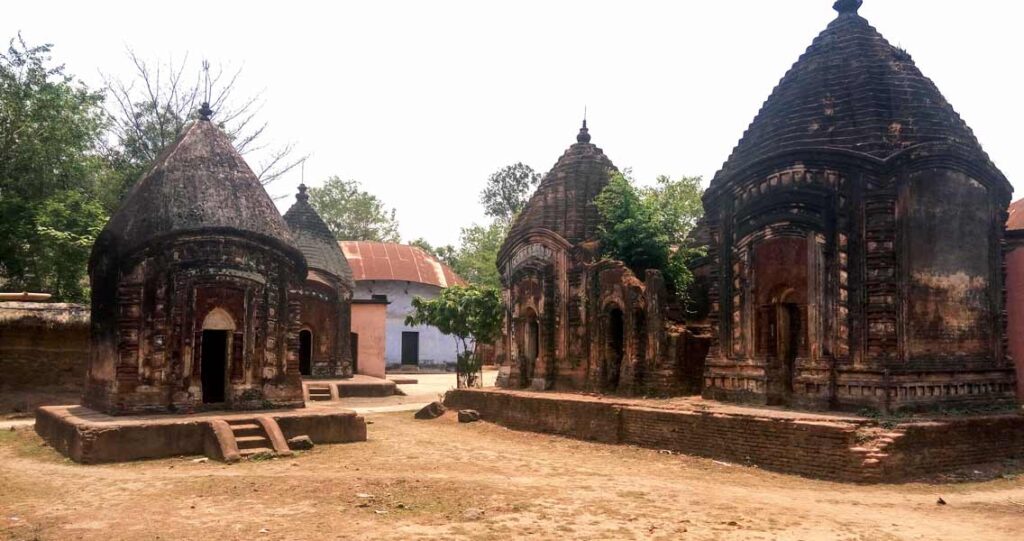Tucked away on the border of Bengal and Jharkhand, Maluti is a nondescript village located around 230 km from Kolkata. Though the village falls under the jurisdiction of Jharkhand, with Dumka being the district headquarters, the inhabitants are all from Bengal. Their ancestors had settled here several years ago. A narrow viaduct on the edge of the village separates the two States.


Surrounded by small hills and lush green fields, the picturesque setting mesmerises every visitor. The sound of the flowing river Chila is like music to the ears, transporting one away from the hustle and bustle of life.
Maluti is not just bestowed with the gift of Nature. Not many people might be aware that the village was also known as Guptakashi because it had 108 exquisite terracotta temples standing within a radius of 700 metres. Their numbers, however, have come down to 72, as several temples have crumbled to dust because of sheer ignorance and lack of maintenance over the years.
The temples of Maluti have their own unique history. The village first came into limelight in the 15th century as the capital of nankar raj (tax-free kingdom). The credit for turning it into a ‘temple village’ goes to Baj Basanta dynasty whose rulers, instead of building palaces, competed in constructing temples.
The Global Heritage Fund declared Maluti as one of the world’s 12 most endangered cultural heritage sites.
The inscriptions on the temples are in a mix of Bengali, Prakrit and Sanskrit, and contain engravings from epics, pastoral life and of gods and goddesses. The surviving temples are dedicated to Shiva, while the rest are those of Kali, Durga and Vishnu. Interestingly, no particular style of architecture has been followed in Maluti and all popular styles of eastern India have been incorporated and are visible there.
Some historians also believe that the name of the village, originally Mallahati, came from the Malla kings of Bishnupur in Bankura district, who ruled during the 17th and 18th centuries.
Despite its rich history, no attention was paid for the conservation of the temples. The utter neglect including overgrown vegetation and vandalism has taken a toll on the temples, putting a threat on their very existence. The situation had deteriorated so gravely that the Global Heritage Fund declared this as one of the world’s 12 most endangered cultural heritage sites.
The villagers also lost all hope of saving the temples. “We had strived for years but to no avail. The successive governments failed to take any steps for its restoration. We considered it a matter of shame that Maluti was at the brink of losing its heritage and prayed for things to take a turn for better,” says Sanjay Bhattacharya, a villager.
Eventually, their prayers were answered. In 2015, Maluti came to the notice of Prime Minister Narendra Modi during a Republic Day Parade in New Delhi. The tableau on Maluti’s temples was adjudged the second best at the R-Day parade.
It was a momentous event for the State that had made it to the Rajpath only on four earlier occasions, but was never feted. The victory proved to be a turning point as it catapulted Maluti to national fame. The Prime Minister inquired about the condition of the temples and immediately sanctioned around Rs 13 crores for their restoration. An MoU was signed in June 2015, between the State government and the Indian Trust for Rural Heritage and Development, for the conservation, promotion and renovation of these temples.
Subsequently, the conservation of 62 temples began as ten were found to be in good shape.

An unrelenting crusade
The credit for bringing Maluti to limelight goes to Gopaldas Mukherjee (87), a retired Air Force personnel, who led a crusade for over five decades for safeguarding the temples.
Mukherjee, commonly known as Botu da, worked relentlessly to bring the temples to global limelight. Sitting in his 135-year-old house made of mud and straw, he says that he was pained to see the condition of the temples when he returned to the village after his retirement from the Air Force in 1967.
“I was shocked to see the pathetic condition. They were no ordinary structures but had a pedigree of several hundred years but were ignored. I took a vow to do whatever was required to preserve my temple village,” says Botu da, in a passionate, resolute tone.
I want to see people flocking to visit Maluti’s temples. I’ve lived my age and want the restoration work to be over before I bid goodbye to this world.
– Gopaldas Mukherjee
He decided to stay in the village and not move out in search of another job. In 1968, he became the headmaster of the village school and also began to work for the renovation of the temples. “I met several senior officials in Bhagalpur division (as the village was under Bihar then) and updated them about the condition of the temples. My efforts brought results when the Bihar government sanctioned money for their restoration in the early 1980s. But work moved at a snail’s pace over the years and often stopped due to paucity of funds. I had to run from pillar to post urging officials to hasten the restoration process.”
His efforts were recognised by the Jharkhand government as Chief Minister Raghubar Das honoured Botu da with a certificate and cheque of Rs 51,000 in 2015.
Botu da has only one dream. “I want to see people flocking to Maluti to visit the temples. I’ve already lived my age and want the restoration work to be over before I bid goodbye to this world,” he says, as the sun begins to set behind the hillock and dusk envelops the sky.







